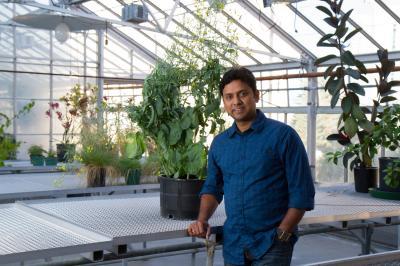The "green seed problem" is a long-standing issue that causes millions of dollars annually in canola crop losses for Canada.
Canola is the major cash crop in Alberta, which produces about 35 per cent of Canada's canola that generates in the province about $5 billion in revenue annually. Across the country, the oilseed crop, whose seeds are pressed into canola oil, contributes about $15 billion a year to the Canadian economy.
However, every year around the time when canola matures, an unpredictable touch of a light frost can damage crop quality and cause severe losses. The discovery of a plant gene regulatory network means plants could be genetically enhanced to prevent green seeds from occurring in mature canola.
"The annual loss in North America alone is close to $150 million from this de-greening issue," says Marcus Samuel, assistant professor and chair of the plant biology program at the University of Calgary. "I want to see this basic science translated into a viable application. Canola is a huge cash crop and we have a real solution to a major problem."

Marcus Samuel. Credit: Riley Brandt, University of Calgary
"Non-lethal" frosts, occurring at temperatures of zero to minus a degree or two Celsius, can result in up to 20 per cent green seeds – as opposed to mature brown or black seeds – in mature canola.
"The frost doesn't kill off the plant, but it 'fixes' the green color in the seeds," Samuel explains.
"Non-lethal" frosts, occurring at temperatures of zero to minus a degree or two Celsius, can result in up to 20 per cent green seeds – as opposed to mature brown or black seeds – in mature canola, he says.
This presence of chlorophyll in mature seeds affects the oil quality, produces unpleasant flavors and odors, and reduces the oil's shelf life. The research team investigated the de-greening process in the model weed species Arabidopsis, whose complete genetic makeup is known and which is a close genetic relative of canola. The research team, using a mutant strain of Arabidopsis that produces mature green seeds, performed genetic analyses that uncovered a pathway required for seed development and removal of unwanted chlorophyll during seed maturation.
They found that a protein that regulates gene expression (how the gene's information is used in synthesizing a functional gene product), called ABI3, is important in removing seed chlorophyll and enabling the seeds to de-green.
In an illustration of how basic science builds upon itself, the researchers identified that ABI3 regulated expression of a gene mapped in 2007 as controlling chlorophyll degradation and resulting in yellow versus green seed color. This color difference was first identified as a trait in the 1800s by genetics pioneer Gregor Johann Mendel, who used it as a marker to study the inheritance of traits.
The team also showed that a higher expression of ABI3 in Arabidopsis led to seeds that were able to de-green normally to produce mature brown-black seeds, despite harsh cold treatments.
"This overexpression allows these plants to withstand cold much better and for the system to be functional even though it's hit with cold," Samuel notes.
"Given the similarity of Arabidopsis and canola, it would be easy to isolate the same genes from canola and use transgenic technologies (which introduce new genes into organisms) to create varieties that could withstand freezing conditions yet produce mature brown-black seeds," he says.
"We actually have demonstrated in our laboratory tests that the canola genes work the same way."





Comments